Tamarind rice recipe with step by step photos – popular South Indian recipe of a tangy, sour & spiced rice. The recipe dish is also known as puliyodharai in the Tamil language. A Tamil Nadu delicacy, Puliyodharai Recipe is a vegan one and a supremely addictive dish. Try it to know.
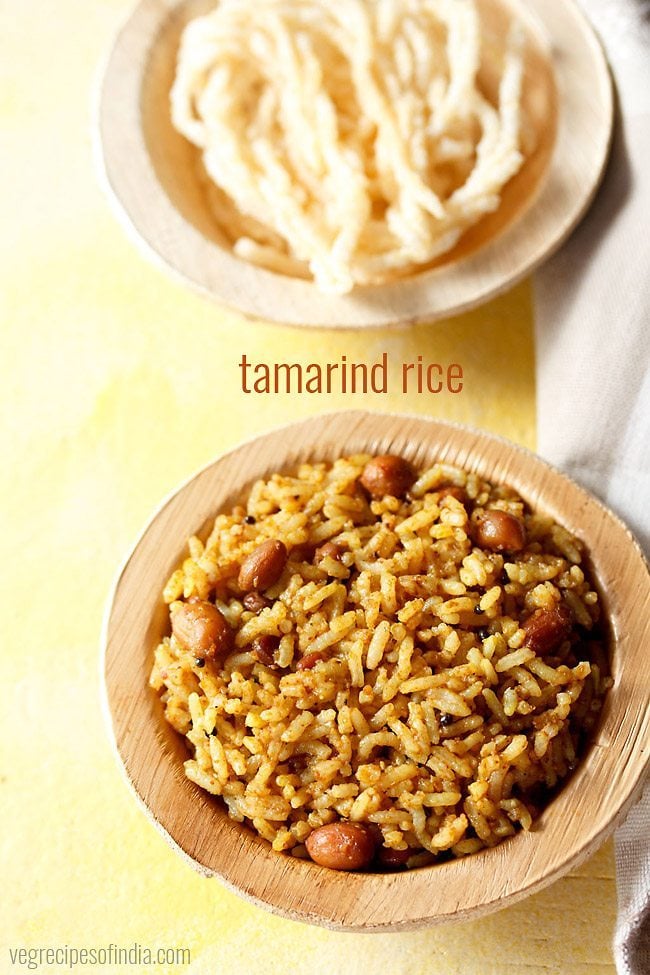
Sharing again one of those recipes, which I should have added long ago. Tamarind rice is often made in South Indian homes. There are many ways and variations of this recipe.
Two method through which we can make tamarind rice are :
- The rice is first cooked and then mixed with tamarind sauce or pulikachal.
- The second method is where the raw rice is cooked in the tamarind sauce.
I am sharing here the traditional method. usually the spiced tamarind sauce also known as ‘Pulikachal‘ is made in medium or large quantities and then stored in the fridge. So when you want to make tamarind rice, you just heat a bit of sesame oil. Add the pulikachal. Add the cooked rice. Mix well and your tamarind rice is ready. You can also mix the cooked rice with some turmeric powder and sesame oil and then mix with pulikachal.
The recipe I am sharing today is where I have prepared the pulikachal and the entire pulikachal is used in the rice. I already have pulikachal stored in the fridge, so thought of sharing the entire recipe. You can even make the pulikachal from this recipe and store in the fridge.
Preparing tamarind rice takes a lot of time. So you can prepare the pulikachal and store in the fridge. Whenever you want to prepare just cook rice. Then mix rice with pulikachal.
In most South Indian temples, tamarind rice is also served as prasadam along with sweet Pongal and Curd Rice (Daddojanam).
Usually I fry some vadagams with tamarind rice and serve. and at times serve with some curd. You can even have tamarind rice plain.
Since tamarind has a longer shelf life, tamarind rice also goes well for picnics or long journeys. It also makes for nice tiffin box lunch.
How to make Puliyodharai or Tamarind Rice
A) cooking rice:
1. Rinse 1 heaped cup sona masuri (230 grams) very well in fresh water. Then add the rice to a stovetop pressure cooker. Also add ¼ to ⅓ teaspoon salt or add as required.
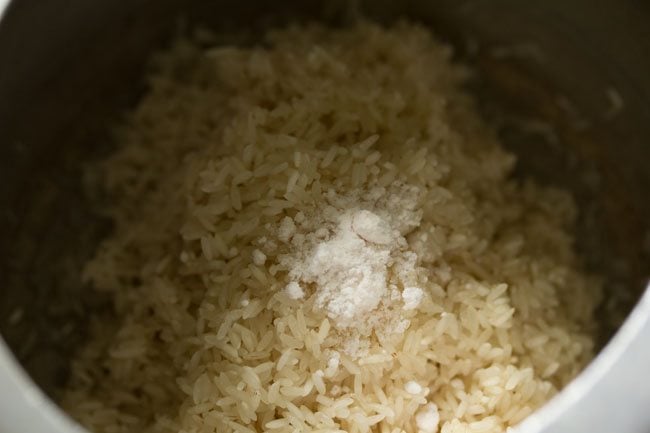
2. Add 2.5 cups water. You can add water depending on the quality of rice. Since I have not soaked the rice, I have added 2.5 cups water and also this rice takes a long time to cook, as its hand pounded sona masuri rice.
For a regular variety, you can add 2 cups water.
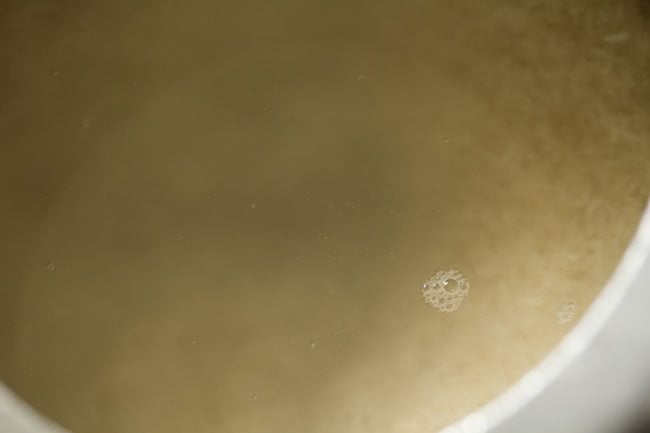
3. Pressure cook for 10 to 12 minutes or for 3 to 4 whistles or till the rice is cooked well. Do ensure that the rice does not get overcooked.
For the hand pounded sona masuri rice, I pressure cooked rice for 14 minutes. When the pressure settles down on its own, then only remove the lid of the cooker. Gently fluff the rice.
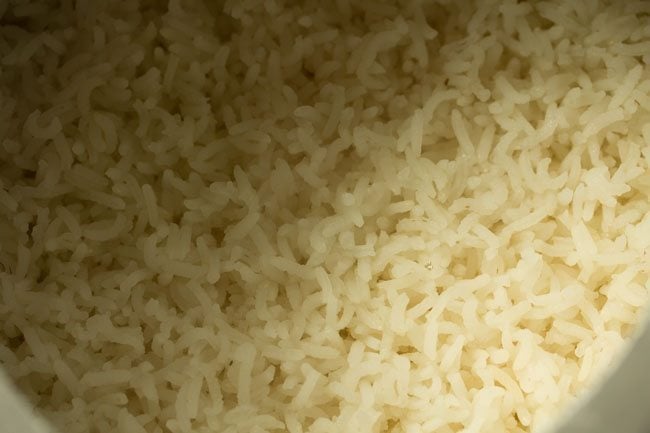
4. Remove the cooked rice in a large plate or tray or a large bowl and allow it cool.
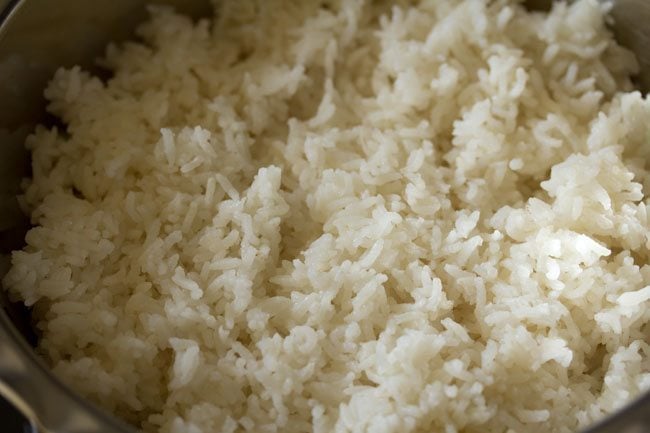
5. When the rice becomes warm, add ¼ teaspoon of turmeric powder and 1 tablespoon of sesame oil to it.
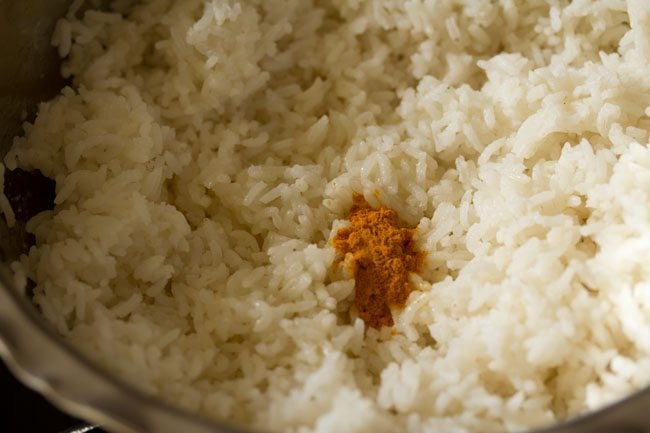
6. Mix well and keep aside. Mix gently so that the rice grains do not break. If there are lumps, then break the lumps.
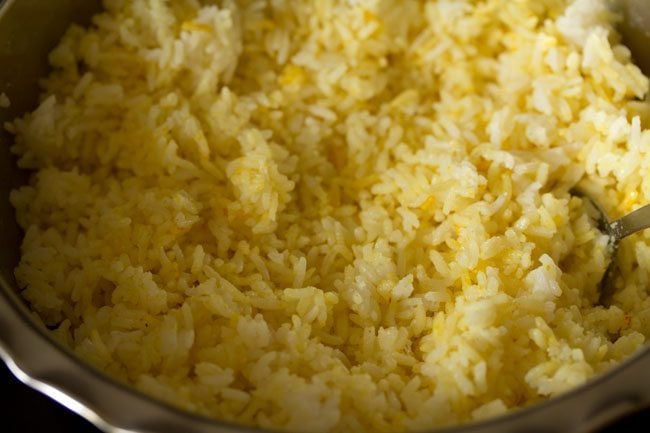
B) preparing tamarind pulp
1. Take 50 grams tamarind or ⅓ cup tamarind (not tightly packed) in a bowl.
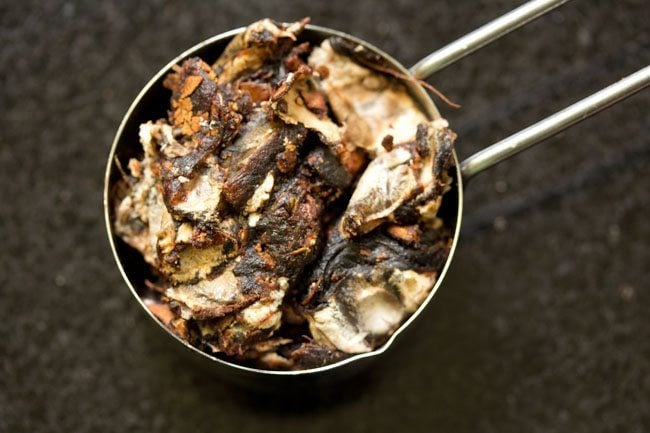
2. Add 2 cups hot water and soak the tamarind for 30 to 40 minutes.
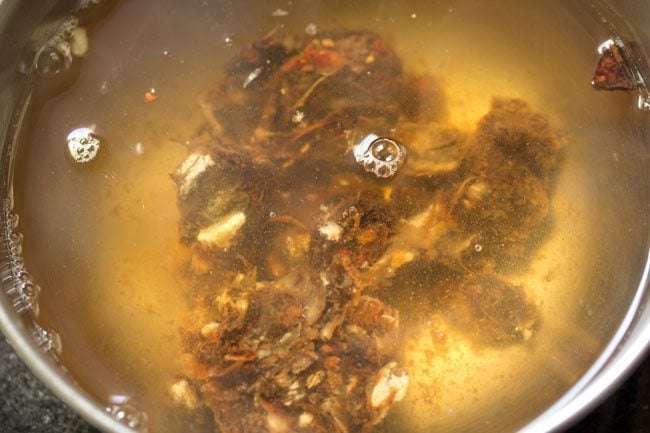
3. Then squeeze the soaked tamarind and extract the pulp. Keep the bowl aside.
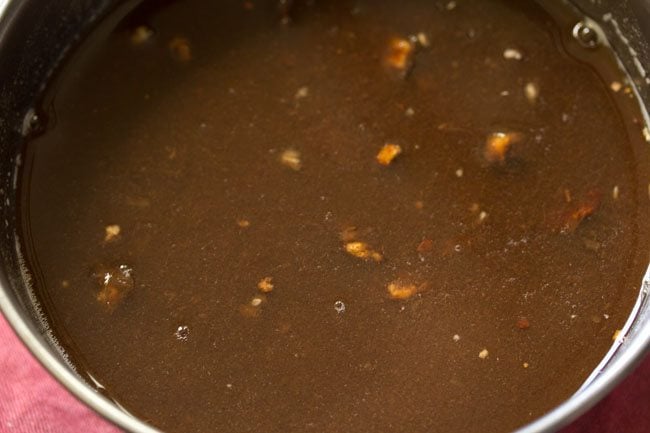
Preparing puliyodharai masala
1. The following spices will be needed to make the masala:
- 3 to 4 dry red chillies
- 2 teaspoons coriander seeds
- 1 teaspoon chana dal (split and husked bengal gram)
- ¼ teaspoon whole black pepper
- ¼ teaspoon fenugreek seeds (methi seeds)
- ½ teaspoon sesame seeds
- 1 teaspoon urad dal (split and husked black gram)
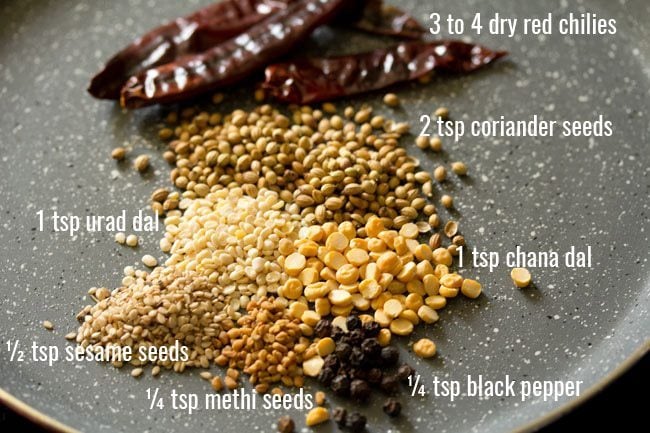
2. Heat a pan and reduce the flame to a low. Add all the spices and stirring often roast them on a low flame or sim.
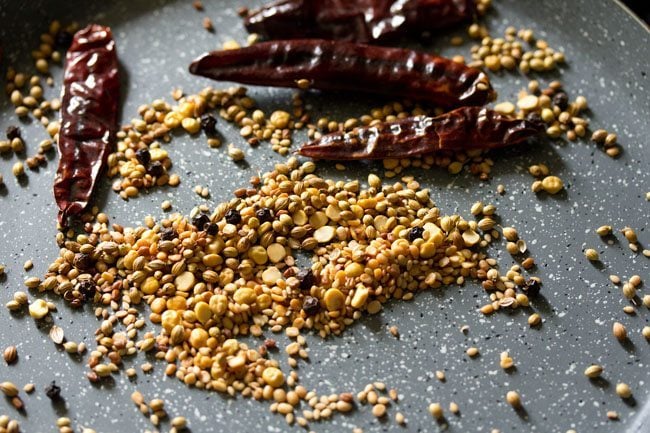
3. Roast till the urad dal and chana dal become light golden or golden. The entire mixture will become aromatic.
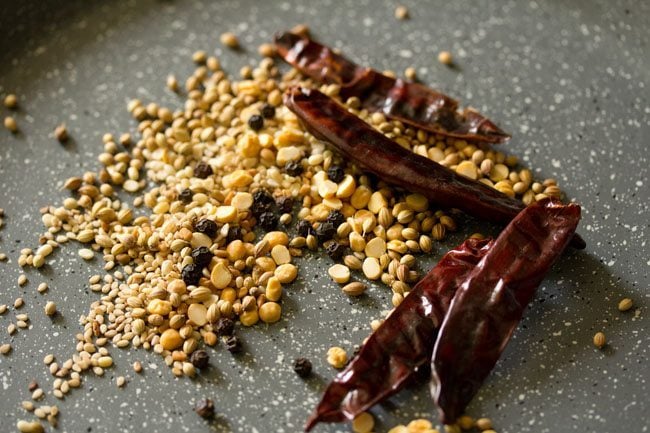
4. Once the lentils have browned well, then switch off the flame and add ¼ teaspoon asafoetida (hing).
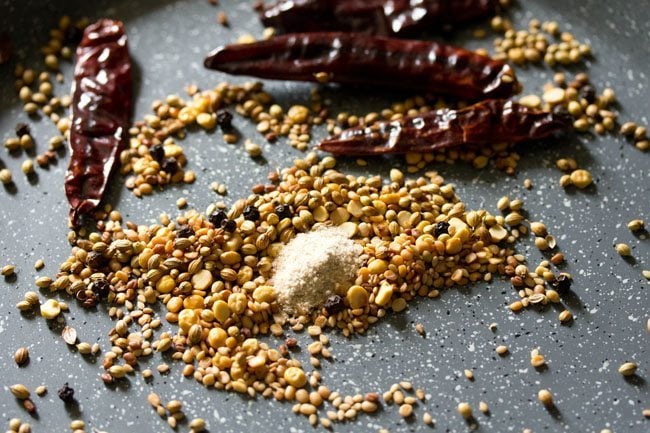
5. Mix very well and let the roasted spices cool.
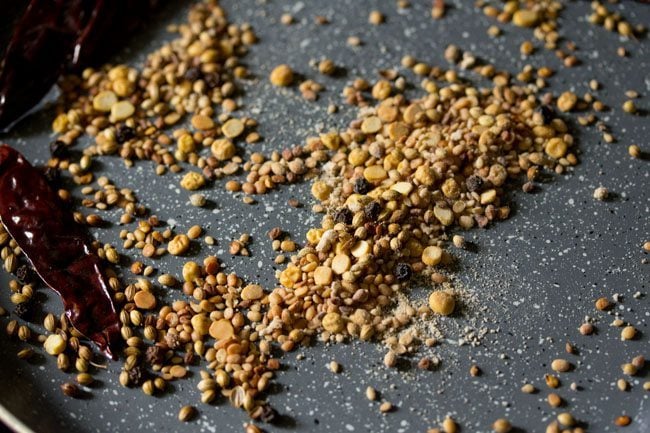
6. Then in a dry grinder or a spice grinder, add all the spices. Break the red chilies and then add.
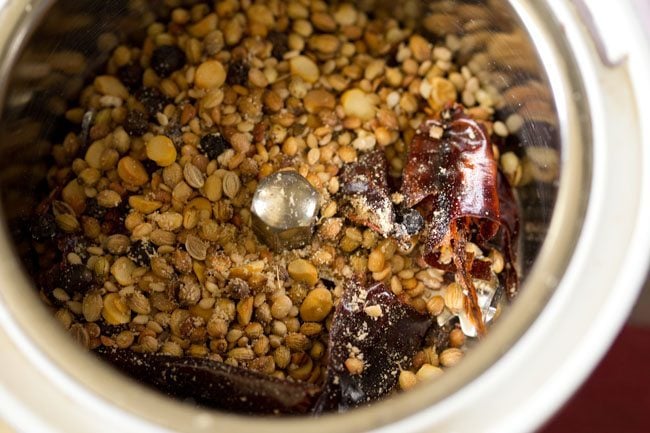
7. Grind to a fine powder. Keep aside.
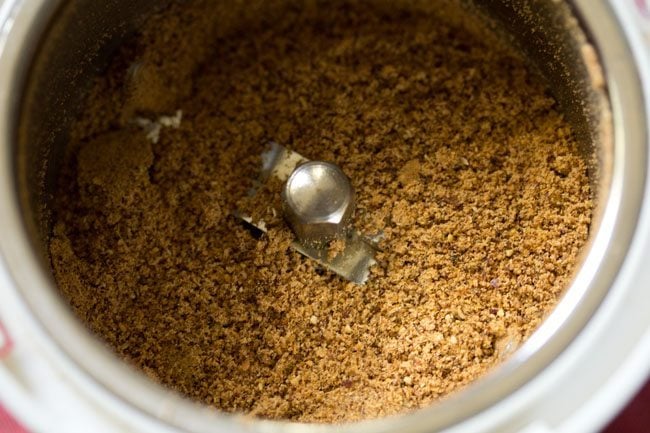
Making pulikachal for tamarind rice
1. Heat 3 tablespoon of sesame oil in a pan.
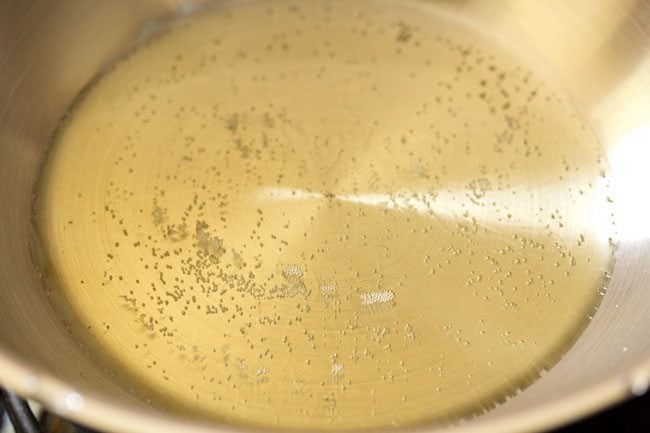
2. Add 1 teaspoon mustard seeds and 1 teaspoon urad dal.
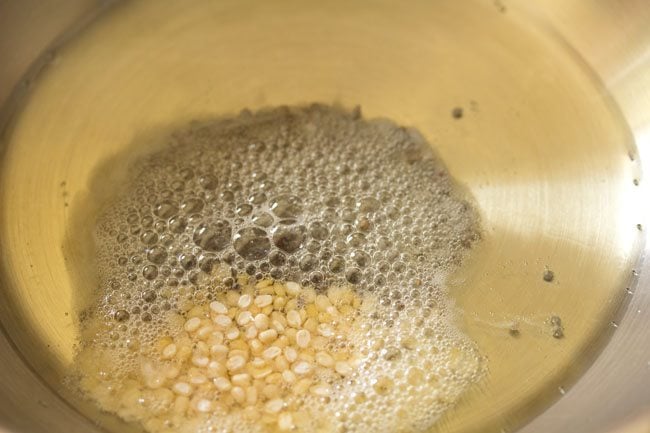
3. Also add 1 teaspoon chana dal and ¼ cup peanuts. Basically add the mustard seeds, lentils and peanuts together.
Here I am showing in step wise parts. If you want you can roast or fry the peanuts separately also and add in the rice towards the end.
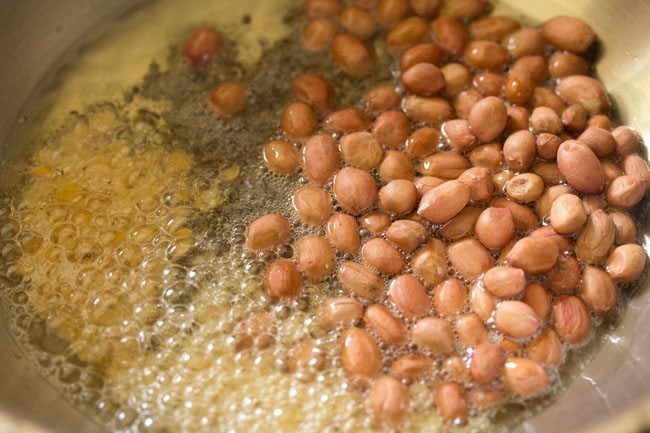
4. Saute on a low flame till the lentils turn golden. The peanuts will also get done by this time.
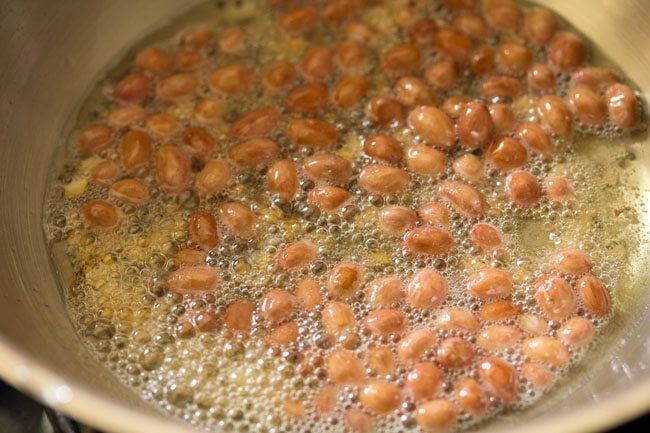
5. Saute till the peanuts and the lentils turn golden. Do saute on a low flame or sim.
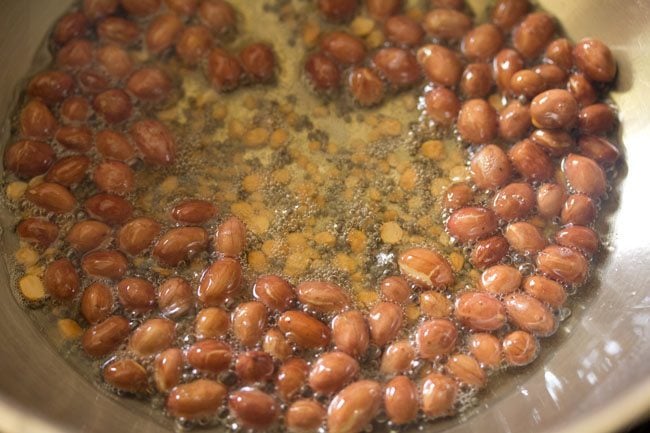
6. Once the peanuts as well as the lentils turn golden, then add 2 to 3 dry red chillies, ¼ teaspoon turmeric powder and 10 to 12 curry leaves. You can even switch off the flame if you want.
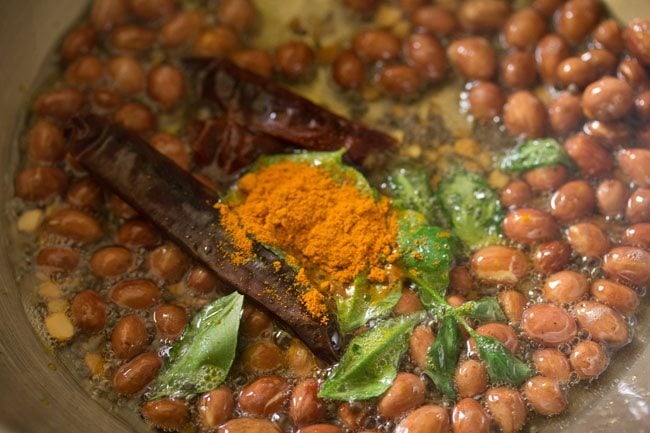
7. Also add a pinch of asafoetida (hing). Stir and mix well.
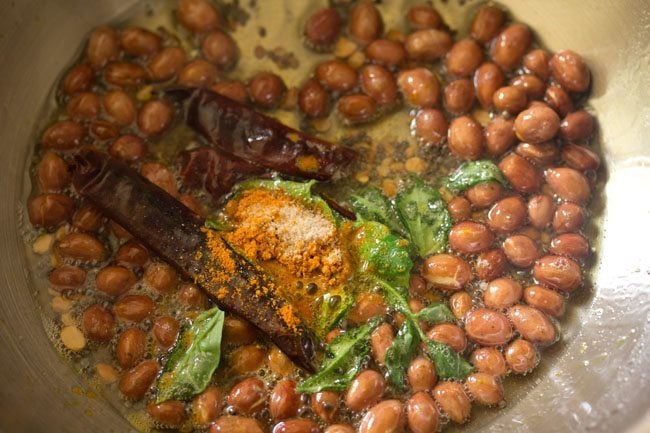
8. Now strain the tamarind pulp and directly add in the tempering mixture. Strain very well. You can even strain tamarind pulp before and keep aside.
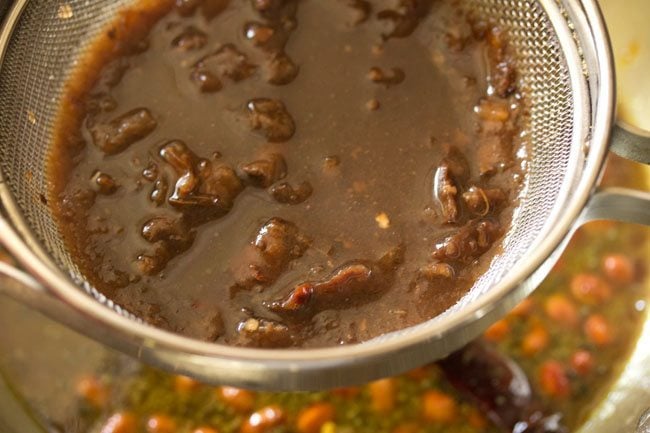
9. Stir and mix everything.
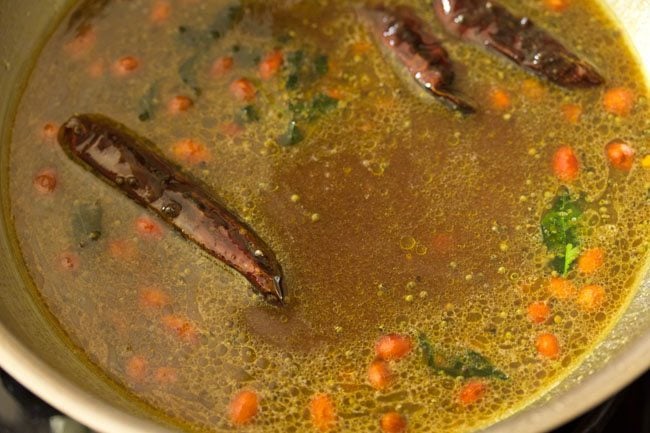
10. Add salt as per taste.
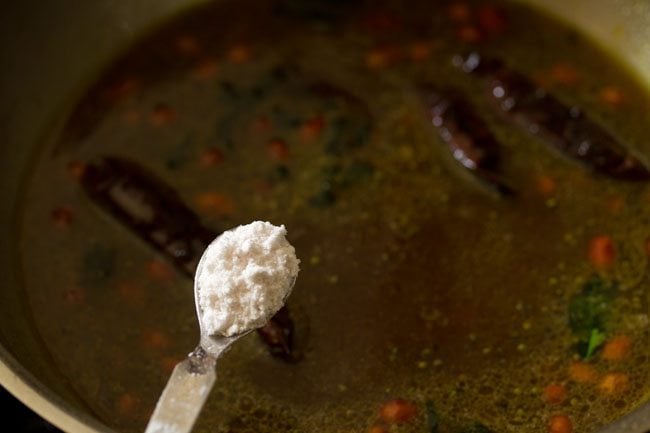
11. Add 1 to 2 teaspoons of jaggery powder. You can add less or more of jaggery or skip it.
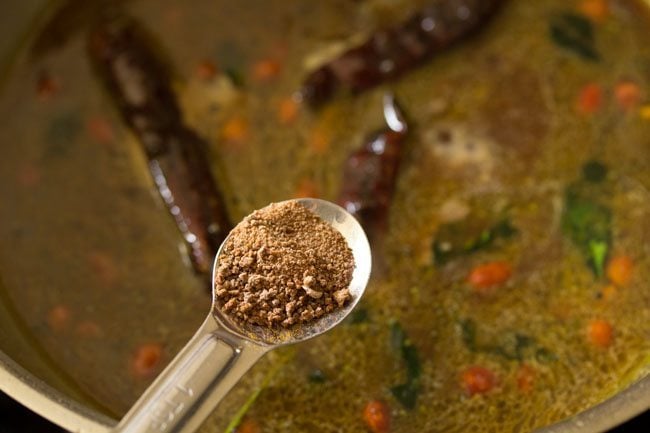
12. Mix well and simmer the mixture on a low to medium flame.
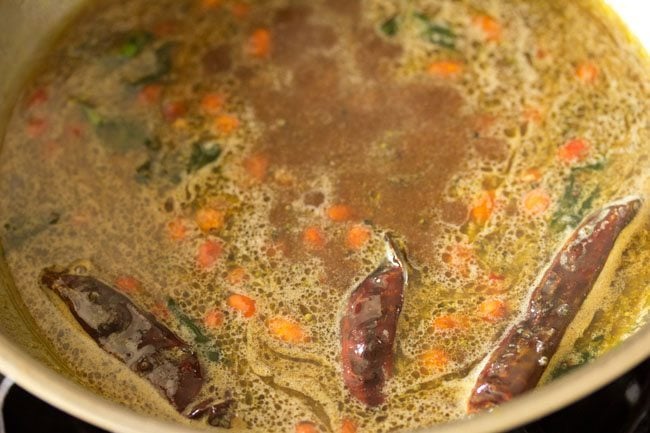
13. Bring this tamarind mixture to a boil and continue to cook.
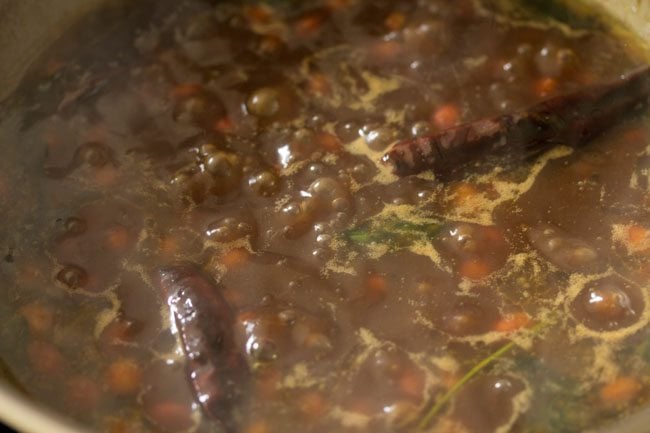
14. Cook till the mixture has thickened a bit and you see oil floating on top.
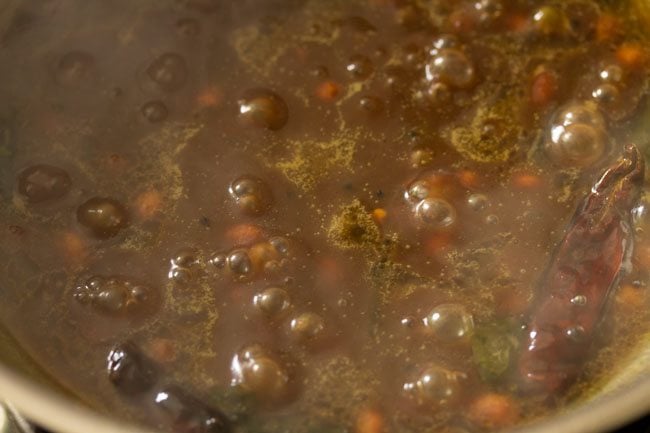
15. Then add the ground spice powder.
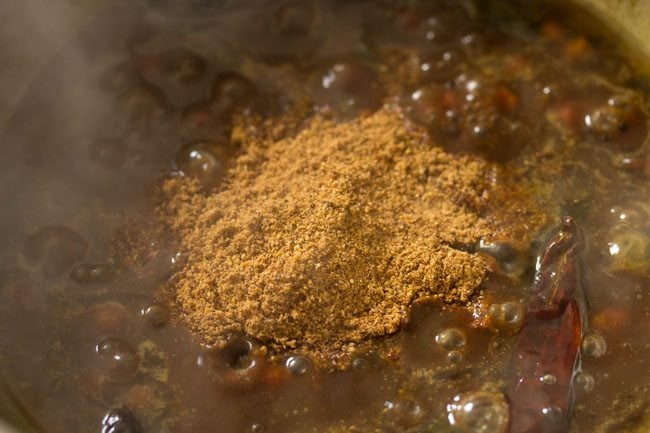
16. Stir and mix very well.
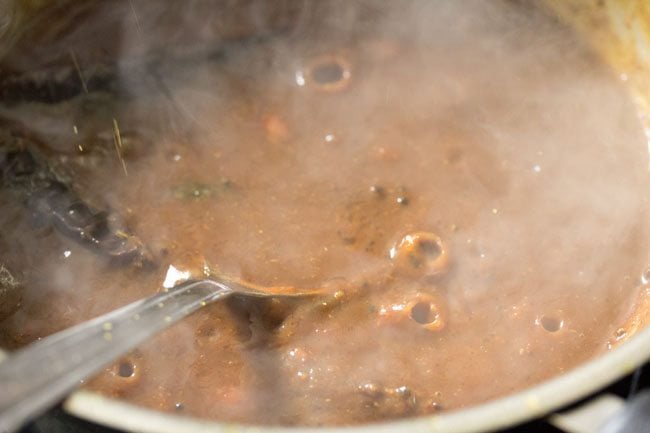
17. Continue to simmer the pulikachal for some more minutes. Do stir often.
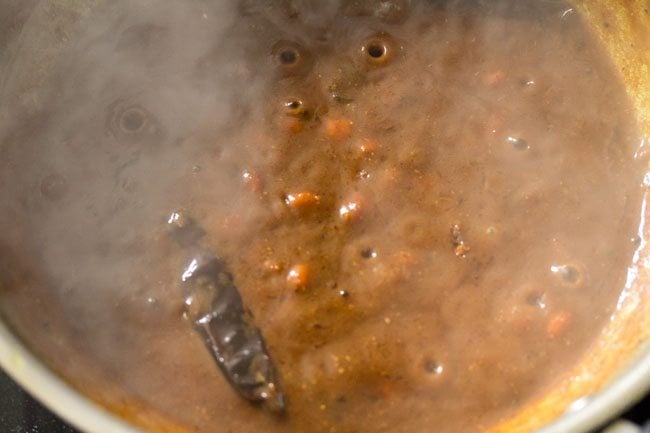
18. Cook till the mixture becomes thick like a thick tamarind sauce or chutney.
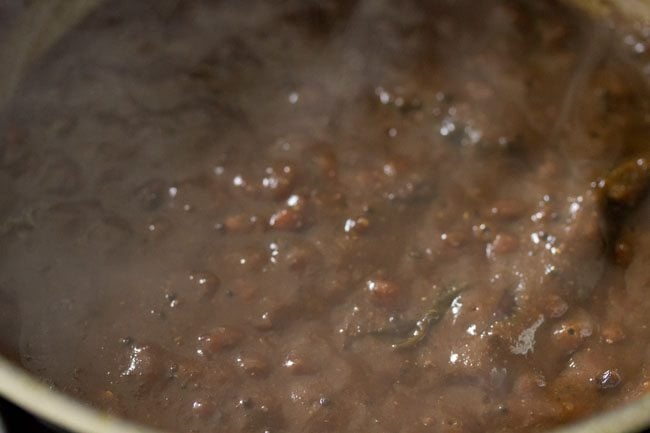
19. Once this consistency is achieved, then switch off the flame.
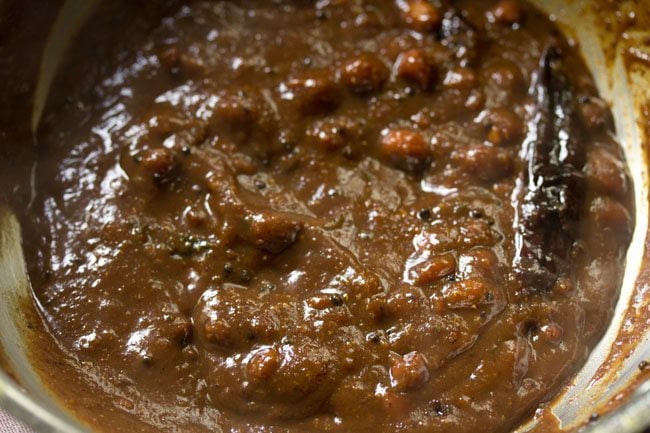
21. keep the pan down.
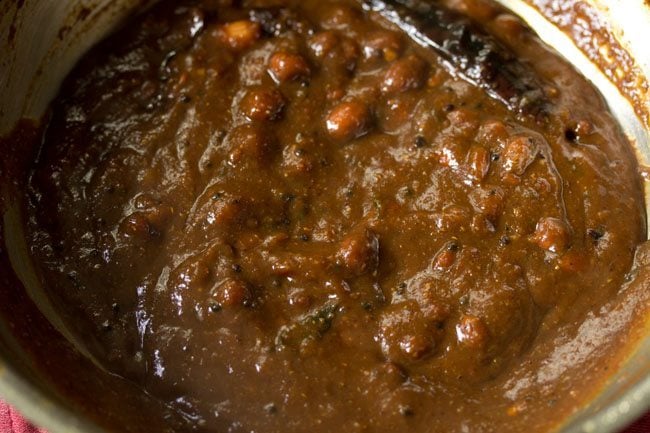
Making tamarind rice
22. Add the pulikachal to the rice.
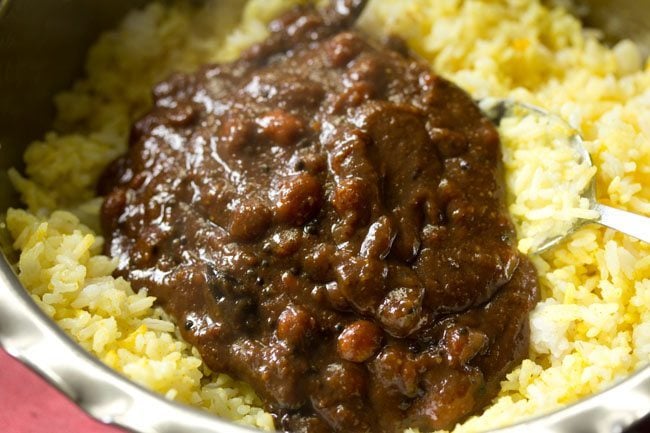
23. Gently mix very well.
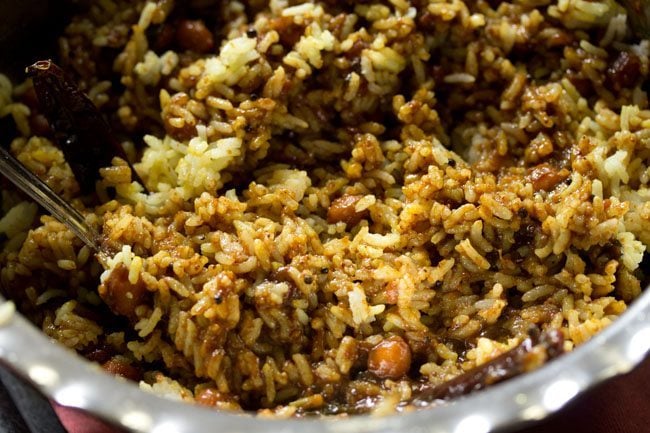
24. After the mixing is done, you can serve right away or wait for some minutes for the flavors to infuse and then serve.
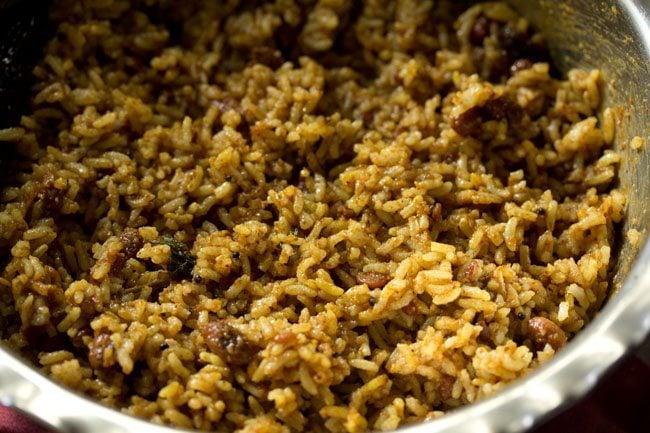
25. Serve tamarind rice with fried vadagams or papads.
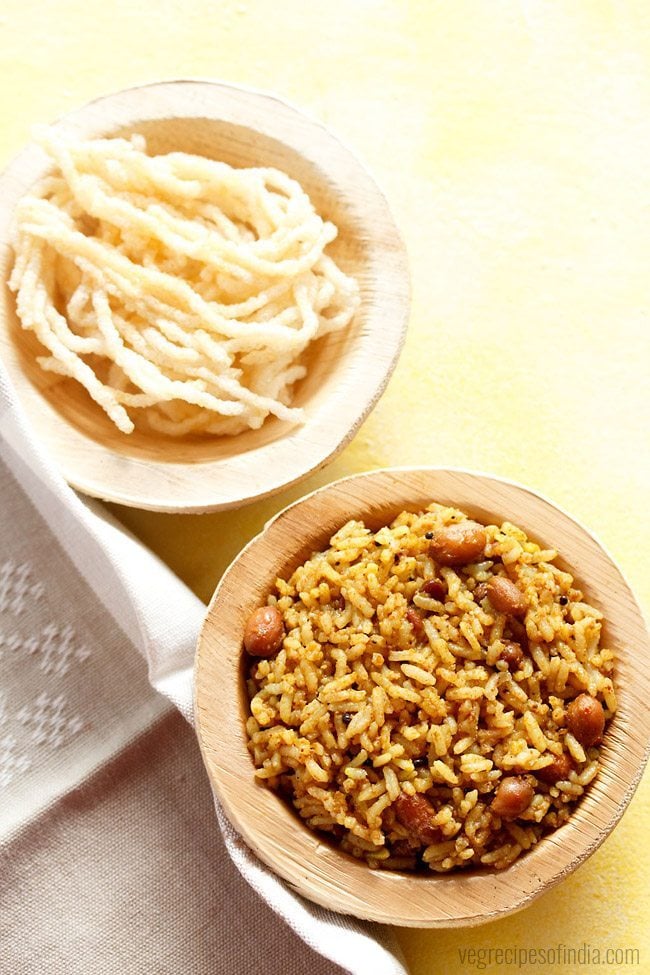
More popular rice recipes
Please be sure to rate the recipe in the recipe card or leave a comment below if you have made it. For more vegetarian inspirations, Sign Up for my emails or follow me on Instagram, Youtube, Facebook, Pinterest or Twitter.
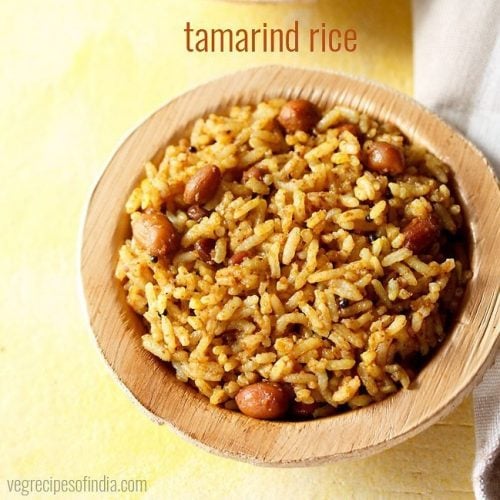
Tamarind Rice | Puliyodharai Recipe
Ingredients
for cooking rice
- 1 cup heaped sona masuri rice or 230 grams rice or 4 cups cooked rice
- ¼ to ⅓ teaspoon salt or add as required
- 2 to 2.5 cups water for cooking rice
- ¼ teaspoon turmeric powder
- 1 tablespoon sesame oil
spice powder for tamarind rice
- 4 dry red chillies
- 2 teaspoons coriander seeds
- 1 teaspoon chana dal (split and husked bengal gram)
- 1 teaspoon urad dal (split and husked black gram)
- ¼ teaspoon fenugreek seeds (methi seeds)
- ¼ teaspoon whole black pepper
- ½ teaspoon sesame seeds
- ¼ teaspoon asafoetida (hing)
tamarind pulp
- 50 grams tamarind or ⅓ cup tamarind – not tightly packed
- 2 cups hot water for tamarind pulp
tempering and other ingredients for tamarind rice
- 3 tablespoons sesame oil
- 1 teaspoon mustard seeds
- 1 teaspoon urad dal (split and husked black gram)
- 1 teaspoon chana dal (split and husked bengal gram)
- ¼ cup peanuts
- ¼ teaspoon turmeric powder
- a pinch of asafoedita (hing)
- 1 sprig curry leaves or 10 to 12 curry leaves
- 2 to 3 dry red chillies
- 2 teaspoons jaggery powder
- salt as required
Instructions
cooking rice
- Rinse 1 heaped cup sona masuri (230 grams) very well in water. Then add the rice in a pressure cooker. Also add 1/4 to 1/3 teaspoon salt or add as required.
- Add 2.5 cups water. You can add water depending on the quality of rice. Since I have not soaked the rice, I have added 2.5 cups water and also this rice takes a long time to cook as its hand pounded sona masuri rice. For a regular variety, you can add 2 cups water.
- Pressure cook for 10 to 12 minutes or 3 to 4 whistles or till the rice is cooked well. Do ensure that the rice does not get overcooked. For the hand pounded sona masuri rice, I pressure cooked for 14 minutes. When the pressure settles down on its own, remove the lid. Fluff the rice.
- Remove the cooked rice in a large plate or tray or a large bowl and allow it cool.
- When the rice becomes warm, add 1/4 teaspoon turmeric powder and 1 tablespoon sesame oil to it.
- Mix well and keep aside. Mix gently so that the rice grains do not break. If there are lumps, then break the lumps.
preparing tamarind pulp
- Take 50 grams tamarind or 1/3 cup tamarind (not tightly packed) in a bowl.
- Add 2 cups hot water and soak the tamarind for 30 to 40 minutes.
- Then squeeze the soaked tamarind and extract the pulp. Keep the bowl aside.
preparing puliyodharai masala or spice mix
- Heat a pan and then reduce the flame to a low.
- Add all the whole spices mentioned under the list title ‘spice powder’ except asafoetida.
- Stirring often roast them on a low flame or sim.
- Roast till the urad dal and chana dal become light golden or golden. The entire mixture will become aromatic.
- Once the lentils have browned well, then switch off the flame and add 1/4 teaspoon asafoetida/hing.
- Mix very well and let the roasted spices cool.
- Then in a dry grinder or a spice grinder, add all the spices. Break the red chilies and then add.
- Grind to a fine powder. Keep aside.
making pulikachal for tamarind rice
- Heat 3 tablespoon sesame oil in a pan.
- Add 1 teaspoon mustard seeds, 1 teaspoon urad dal
- Also add 1 teaspoon chana dal and 1/4 cup peanuts. If you want you can roast or fry the peanuts separately also and add in the rice towards the end.
- Saute on a low flame till the lentils turn golden. The peanuts will also get done by this time.
- Once the peanuts as well as the lentils turn golden, then add 2 to 3 dry red chillies, 1/4 teaspoon turmeric powder/haldi and 10 to 12 curry leaves. You can even switch off the flame if you want.
- Also add a pinch of asafoetida. Mix well.
- Now strain the tamarind pulp and directly add in the tempering mixture. Strain very well. You can even strain tamarind pulp before and keep aside. Stir and mix everything.
- Add salt and 1 to 2 teaspoons of jaggery powder. You can add less or more of jaggery or skip it.
- Mix well and simmer the mixture on a low to medium flame.
- Bring this tamarind mixture to a boil and continue to cook.
- Cook till mixture has thickened a bit and you see oil floating on top.
- Then add the ground spice powder.
- Mix very well.
- Continue to simmer the pulikachal for some more minutes. Do stir often.
- Cook till the mixture becomes thick like a thick tamarind sauce or chutney.
- Once this consistency is achieved, then switch off the flame. Keep the pan down.
making tamarind rice
- Add the pulikachal to the rice.
- Gently mix very well.
- After the mixing is done, you can serve right away or wait for some minutes for the flavors to infuse and then serve.
- Serve tamarind rice with fried vadagams or papads.
Nutrition Info (Approximate Values)
This Tamarind Rice post from the archives first published in October 2016 has been updated and republished on January 2023.
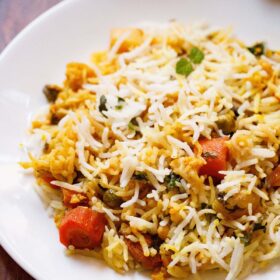
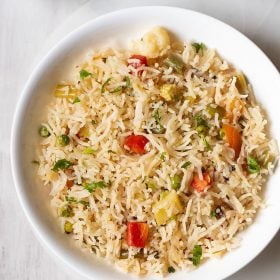
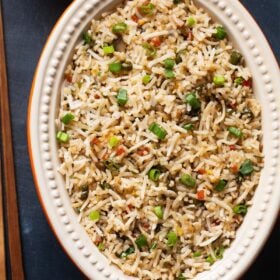
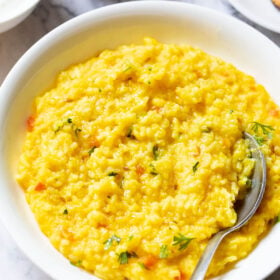








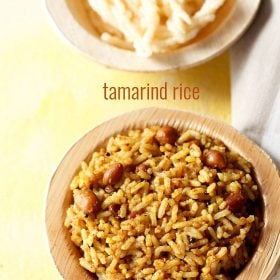
Recently I’ve been searching for different style of rice making. So good I found this recipe! Going to try it for sure!
Oh wow never new i could make rice like this!
Tried exactly with each step. Came out perfectly 🙂
Nice to know and thanks for the feedback and the rating.
Thankyou for sharing this recepie. I luv this rice but since I didn’t have the ready made masala I couldn’t prepare it for this long and now that I have this recepie of yours this the first thing I am gonna make.
Welcome Manchali and I hope you like the recipe.
Hi Dassana
We use only Jasmine rice or Basmati rice at home. Tried sona masuri rice once but I didn’t care for that. My question is: either Jasmine or Basmati can be substituted in this recipe instead of sona masuri rice? Keep up the great work! Thanks
rom, basmati rice works well. jasmine rice will become sticky. welcome.
All ur recipies r great.keep up the good work.
Thanks Gokilavani for your positive feedback on recipes.
If not jaggery can sugar be used ?
Archana, yes you can use sugar.
Tried it today for small quantity and came out awesome.. you rock ????????????????
thanks seema
Hello
I tried this receipe .This is awasome. Very tasty.
thanks monika for this feedback. nice to know.
Hi, is it okay if I use Mothers Recipe Tamarind paste instead of the pulp? Will it still work?
you can try. it should work.
Hello,
You are simply the best in terms of posting your recipes , sharing the alternatives for cooking, style of making every dish perfectly and above all I really appreciate the effort which you do while uploading the images step my step.
I have never cooked before I got married but now I have to cook 🙂 and I guess I learned it from your website. Sometime I use to be in rush so I just choose any of the vegetarian dish from your website go at the bottom take glimpses of the recipe and do my cookings.
All the best wishes from my side and may success comes to you always 🙂
Thanks a lot Shruti for this awesome and positive feedback. I am touched. Wish you all the best.
Woooww..this is how my granny used to make and for some time my mom when we were very young. These days, no one add’s those spice powder mix. Loved to see the old recipe back.
Thanks Sirisha for this awesome feedback. We like to present most recipes in the same way as they are made without any shortcuts.
tried it. came out fantastic.
Another super recipe – followed it step by step and it came out awesome! I just have one suggestion – to add ginger in the tamarind pulp as i have seen many of my south indian friends do so….it definitely enhances the taste. Keep up the good work and thanks for a being a perfect cooking guide!
welcome jyoti. thanks for sharing this suggestion. i will try this out when i make the tamarind rice next time.
thanks for the recipe dassana ji…. it was temple taste 🙂
thank you sanjai 🙂
super, will try it for sure
Thanks Vishalakshi
Thank you Dassana for posting this tamarind rice
I like this method and will try it for sure
Happy Navaratri
thanks jan. happy navratri festival to you too.
tried it and came out really well. thank you dassana 🙂 god bless !
thanks aishwarya for positive views 🙂